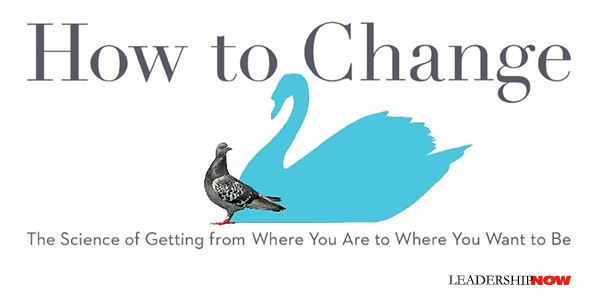 |
 |
08.10.21

How to Change
YOU WANT TO CHANGE, but the problem is you haven’t found the right strategy. You need to outsmart your issues. In How to Change, behavioral scientist Katy Milkman says we need to tailor our approach to fit the obstacle and our circumstances. We search for solutions that will deliver the quick knockout victory and tend to ignore the specific nature of our adversity. The surest path to success is not one-size-fits-all. Instead, you must match your approach to your opponent. You’ll get further faster if you customize your strategy: isolate the weakness preventing progress, and then pounce. Whether internal or external, the key to change is understanding your opponent—the obstacle. Milkman takes a look at seven of those obstacles. Change is easier when you have a blank slate with no old habits working against you. This is often not possible, but you can create the feeling of a blank slate. Life events, anniversaries, or new chapters in your life can signal a clean slate. “These new chapters are moments when the labels we use to describe ourselves, who we are, and what we’re living through shift, compelling us to shift with them…. And labels matter to our behavior.” There is a downside to fresh starts. If you are doing well, a fresh start can be an interruption and become a setback. If you are doing poorly, the disruption can work to your advantage. A fresh start is just that. To maintain that motivation to change, you will need to consider other obstacles that will tempt you to quit. Once you begin, the present temptations can loom larger than the long-term rewards of sticking to your goal. One strategy is to bundle your temptation with an activity that you are trying to avoid—like binge-watching TV while exercising. Another strategy is to make your change initiative fun by adding rewards, a sense of competition, and leaderboards. Milkman notes, however, “gamification works when players ‘buy in’ to the game. It can backfire if players feel the game is being imposed on them.” When we feel like putting off the change, a commitment device can be just the thing to overcome procrastination. A cash incentive (or rather a disincentive) can be very effective. Commitment devices “help us change our behavior for the better by locking us into choices we make when we’re clearheaded about what’s good for us, not when we’re hotheadedly reacting to an imminent temptation, and they keep us from indulging in the temptation to misbehave later on.” Stuck in our routines, it is easy to forget to do those out-of-the-ordinary things we want to do. We often resort to reminders, but the timing has to be just right, or we forget those too. Reminders work best when we can act on them immediately. The strategy here just may be implementing cues—linking the desired behavior to a specific clue that will remind us to act. “Often, when we make plans, we don’t focus on what will trigger us to act. Instead, we focus on what we intend to do.” So, fill in the blank: “When ______ happens, I’ll do ______.” “While any cue is better than no cue, it’s best to rely on clues that are out of the ordinary.” Some changes never make it out of the gate because we just don’t feel like it. We’re lazy. “When faced with repeated decisions, laziness is harder to tackle.” So, we need to form new habits. Duh. But there are ways to help you make that happen. One important way is to build flexibility into your schedule. “Forming stable routines is key to habit formation. But if we want to form the ‘stickiest’ possible habits, we also need to learn how to roll with the pinches, so we can be flexible when life throws us a curveball. Too much rigidity is the enemy of a good habit.” Milkman also recommends we should aim for streaks by tracking our efforts. Tracking helps you “avoid forgetting to do it until it becomes second nature.” A lack of confidence also thwarts our change efforts. “Research confirms the obvious: when we don’t believe we have the capacity to change, we don’t make as much progress changing.” It is natural to give people who are struggling advice, but it also tends to lower their confidence. Instead, try asking them to give advice to someone in their situation. “Encouraging someone to share their wisdom conveys that they’re intelligent, capable of helping others, a good role model, and the kind of person who succeeds. It shows that we believe in them.” When trying to make a change, seek out others doing what you are trying to do. Milkman calls this strategy “copy and paste.” “So if you want to get fit, tip books will surely help, but if you can spend some time with fit peers and watch out for ideas, you’ll likely do even better.” Since our peers heavily influence our choices, hanging out with people who are doing what we want to do provides some motivation and accountability. When the barriers to change are internal, the key to success is to tackle them with a tailored suit of solutions and to treat change as a chronic challenge rather than a temporary one. 
Posted by Michael McKinney at 10:35 PM
|
BUILD YOUR KNOWLEDGE
 

How to Do Your Start-Up Right STRAIGHT TALK FOR START-UPS 
Grow Your Leadership Skills NEW AND UPCOMING LEADERSHIP BOOKS 
Leadership Minute BITE-SIZE CONCEPTS YOU CAN CHEW ON 
Classic Leadership Books BOOKS TO READ BEFORE YOU LEAD |